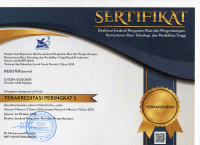Single women navigating disenfranchised grief in Elizabeth Gaskell's Cranford
Abstract
Written during the Victorian Era, Elizabeth Gaskell’s Cranford (1853) explores social issues related to gender. This study focuses on how the main characters of the novel, the Jenkyns sisters, navigate their loss resulting from being women and single. This qualitative research analyzes the narrative elements of the novel, especially its characters, conflicts and setting, and employs feminist literary criticism to scrutinize the gender relations and inequalities in the novel. Borrowing Kenneth J. Doka’s theory of disenfranchised grief, this study asserts how the community of spinsters and widows in the novel challenges the imposition of women’s identity as wives and mothers. However, while succeeding in managing lives outside of marriage and motherhood, the Jenkyn sisters struggle with grief that cannot be openly acknowledged nor socially validated. Such grief and efforts to conceal lead to psychosomatic symptoms. Remain unmarried, these middle-class women cannot escape social expectations of women in nineteenth-century England that the novel resolves their grief partly by making them a surrogate mother and wife.
Keywords
Full Text:
PDFReferences
Adler, E. (2022). Gaskell Society There’s Something About Mary. Source: The Gaskell Journal, 36, 21–39. https://doi.org/10.2307/48743054
Armstrong, M. A. (2019). Sex and the provincial girl: Desire and time in Elizabeth Gaskell’s Cranford and North and South. Nineteenth Century Gender Studies, 15(3). Retrieved from https://www.ncgsjournal.com/issue153/PDFs/armstrong.pdf
Auerbach, N. (1979). Communities of women : an idea in fiction. Harvard University Press.
Bressler, C. E. (2011). Literary criticism : an introduction to theory and practice. In Pearson Longman (Fifth Ed). Pearson Longman. https://doi.org/LK - https://worldcat.org/title/651487421
Burton, A., & Duffy, D. (2020). Gaskell Society Elizabeth Gaskell and the Industrial Poor. The Gaskell Journal, 34, 1–24. https://doi.org/10.2307/48634415
Clarke, J. (2019). A regular bewty!': Women remaking and remade in Elizabeth Gaskell’s. The Gaskell Journal, 33, 37–50. https://www.jstor.org/stable/48539351
Dickson, M. (2017). Confessions of An English Green Tea Drinker: Sheridan Le Fanu And The Medical And Metaphysical Dangers Of Green Tea. In Victorian Literature and Culture (Vol. 45, Issue 1, pp. 77–94). Cambridge University Press. https://doi.org/10.1017/S1060150316000449
Doka, K. J. (1989). Disenfranchised Grief: Recognizing Hidden Sorrow. Lexington Books.
Doka, K. J. (2002). Disenfranchised Grief: New Directions, Challenges, and Strategies for Practice. Research Press.
Fernandez, J. (2016). ‘Some great war’: The Aga Jenkyns and the repression of history in Elizabeth Gaskell’s Cranford. The Gaskell Journal, 30, 41–56. https://about.jstor.org/terms
Fisher, J. (2019). The Empire of the Tea Table. Source: Victorian Review, 45(2), 208–211. https://doi.org/10.2307/26953062
Gaskell, E. (1998). Cranford. Oxford University Press.
Jung, D. (2017). Critical names matter: “Currer Bell,” “George Eliot,” and “Mrs. Gaskell.” Victorian Literature and Culture, 45(4), 763–781. https://doi.org/10.2307/26788832
Kennedy, X. J., & Gioia, D. (1995). Literature: An Introduction to Fiction, Poetry, and Drama. HarperCollins College Publishers.
Kenney, W. (1966). How to Analyze Fiction. Monarch Press.
Lambert, C. (2018). Elizabeth Gaskell’s Cranford: Performing Masculinity. Victorian Review, 44(2), 177–182.
Merte, M. (2020). Plotting an Economic and Romantic Path Forward. Texas Studies in Literature and Language, 2020(3), 275–296. https://doi.org/10.2307/27117135
Mitchell, C. (1998). C Introduction. In E. Gaskell & E. F. Watson (Eds.), Cranford (2nd ed., pp. vii–xxv). Oxford University Press.
Mitchell, R. N. (2013). Death becomes her: On the progressive potential of victorian mourning. Victorian Literature and Culture, 41(4), 595–620. https://doi.org/10.1017/S1060150313000132
Pinch, A. (2025). Chapter Title: Regret, Remorse, and Realism in Elizabeth In The location of experience: Victorian women writers, the novel, and the feeling of living. Fordham University Press. https://doi.org/10.2307/jj.19583506.7
Ramteke, M. (2021). ‘Elegant Economy’in Elizabeth Gaskell’s Cranford: A Socialist Feminist Study. Global Journal of Human-Social Science, 21((A7)), 45–51. https://doi.org/https://doi.org/10.34257/GJHSSAVOL21IS7PG55
Stoneman, P. (2006). Elizabeth Gaskell: Second Edition. Manchester University Press.
Vázquez, B. P. (2021). Gaskell Society Gaskell and Spanish Culture. Source: The Gaskell Journal, 35, 19–40. https://doi.org/10.2307/48634237
Werner, W. J. (2018). Cranford and the Gothic Everyday . Dickens Studies Annual, 49(1), 155–181. https://doi.org/10.5325/dickstudannu.49.1.0155
Wilson, N., & O’Brien, P. (2020). Introduction: Raymond Williams and Working-Class Writing. Key Words: A Journal of Cultural Materialism, 18, 5–21.
DOI: https://dx.doi.org/10.30659/e.10.2.603-616
Refbacks
- There are currently no refbacks.
Copyright (c) 2025 Eta Farmacelia Nurulhady, Juliati n/a
License URL: https://creativecommons.org/licenses/by/4.0/










